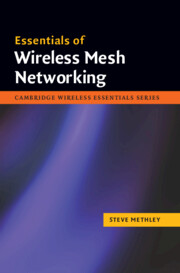Book contents
- Frontmatter
- Contents
- Preface
- Acknowledgements
- 1 Mesh overview and terminology
- 2 Attractive mesh attributes and applications
- 3 Fundamentals of mesh technology
- 4 Mesh capacity, scalability and efficiency – hypothesis testing
- 5 Mesh susceptibility
- 6 Mesh services and quality of service
- 7 Summary of potential mesh pitfalls to avoid
- 8 Appropriate telecommunications applications for mesh
- 9 Successful mesh implementations
- 10 Wireless sensor networks (WSNs) as mesh networks
- Abbreviations
- Selected definitions
- Appendix: Mobility models
- About the author
- Index
- Mesh hints and tips
- Frontmatter
- Contents
- Preface
- Acknowledgements
- 1 Mesh overview and terminology
- 2 Attractive mesh attributes and applications
- 3 Fundamentals of mesh technology
- 4 Mesh capacity, scalability and efficiency – hypothesis testing
- 5 Mesh susceptibility
- 6 Mesh services and quality of service
- 7 Summary of potential mesh pitfalls to avoid
- 8 Appropriate telecommunications applications for mesh
- 9 Successful mesh implementations
- 10 Wireless sensor networks (WSNs) as mesh networks
- Abbreviations
- Selected definitions
- Appendix: Mobility models
- About the author
- Index
- Mesh hints and tips
Summary
Wireless mesh networking is a hot and growing topic, still in its infancy in some ways, whilst already shown to be capable in others. From a military beginning, mesh networks moved to civilian use and are now being deployed worldwide as both local area networks (LANs) and metropolitan area networks (MANs). However, these deployments are still ‘leading edge’ and it is not yet clear what the most enduring applications of mesh will be – particularly as the market moves from early adopters towards widespread take up.
Some of the claims for what a mesh network may deliver have been very ambitious to say the least. In this book we investigate such claims versus the real qualities of mesh networks and identify the key time scales and drivers for the challenges involved with making meshes. Throughout the book we attempt to keep mathematics to a minimum. Where an equation is shown, it remains practical to follow the flow of the book without needing to understand the maths fully.
The book takes a very pragmatic but balanced approach to the issues. We are particularly interested in meshes with an external access capability, for example to the Internet. We supply a technical assessment of mesh and multi-hop networking, highlight the attractions, identify the pitfalls, provide clear and concise hints and tips for success – summarised inside the back cover – and finally evaluate some real-world examples of good mesh applications. These include wireless cities, community networking and vehicular ad hoc networks (VANETs). Wireless sensor networks (WSNs) are another important application of mesh techniques with their own unique challenges, and these receive their own chapter.
- Type
- Chapter
- Information
- Publisher: Cambridge University PressPrint publication year: 2009



